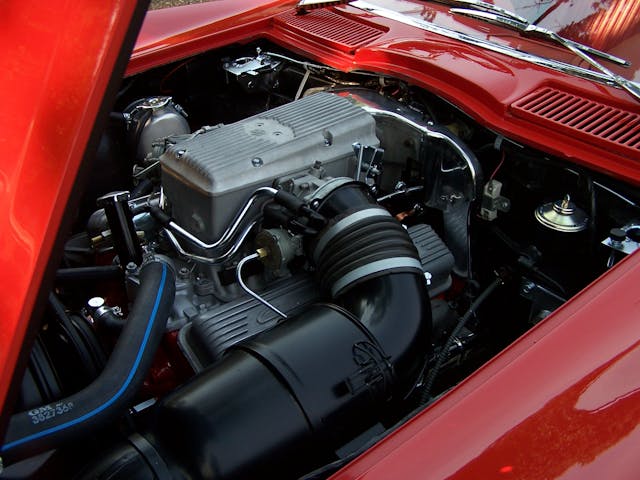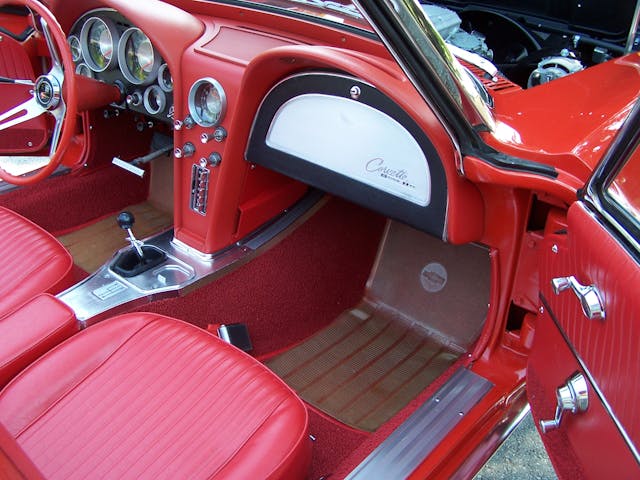Bought by a teen for $1500, this ’63 Corvette is now priceless
Even in his teenage years, Brian Richardson had an eye for Chevrolet Corvettes. Turns out he also had a nose for buried treasure.
Richardson and his identical twin brother, Bruce, bought and sold Corvettes in northern California to help finance their college education in the 1970s, but Brian could never part with one of them: This 1963 convertible, VIN 30867S100003, the earliest-known second-generation (C2) Corvette in existence and now a priceless collectible.
“My mom worked for the DMV, and Brian wanted a fuel-injected Corvette,” Bruce says of his brother, who died unexpectedly two months ago. “He came up with the brilliant idea to have her run the first 20 serial numbers, and he found #00003 in Los Angeles.”
Since Mom Richardson was traveling to Los Angeles anyway, she drove to the address registered with the DMV and spoke to the owner’s wife, who shared two pieces of important information: 1. The car didn’t run, and 2. Her husband had just lost his job. Those two negatives added up to a positive for young Brian, who recounts the story in Larry M. Galloway’s book, Corvette: 1963–1967.

“I flew down soon thereafter and was able to see the car through a garage window,” he told Galloway. “… Later I made a deal with the owner over the phone for $1500. The next weekend my brother and I drove down and picked it up.”
When there simply isn’t another one like it, a car’s value is impossible to pinpoint—or, in the words of our valuation team, priceless. The deal for the Vette—equipped with a 327-cubic-inch, 360-hp V-8 (L84)—was completed on April 26, 1975. Taking inflation into account, the $1500 price tag is the equivalent of $8300 today. As the earliest-production second-gen Corvette in existence, however, it’s in a league of its own. When verified, as this convertible’s status is, the title of “earliest known” holds great weight in the collector market. Such a vehicle can easily sell for more than its top value in the Hagerty Price Guide: In this Corvette’s case, $180,000.
By any measure, Vette was an amazingly shrewd purchase, especially for a 19-year-old college student, but it probably wasn’t all that surprising to anyone who knows the Richardsons.
“We were always into mechanical things, trying to figure out how they worked, learning how to make them work better,” Bruce says. “Our dad died when we were 15. He was a businessman, and he had served as a tank commander in World War II. Our grandfather worked for Lockheed, and all of his tools went to Dad, so we had a lot of them, and we used them a lot.
“When we were 14 or 15, we bought our first car—a three-cylinder, two-cycle German car called an NSU Prince, which is about the size of a Mini Cooper. We drove it around in the back yard. We had go-carts and gas-powered skateboards and …”
Bruce’s wife, Lainey, interjects: “When they were 10, they took apart their mother’s washing machine, fixed it, and put it all back together. Can you believe that? Ten!”

Brian and Bruce went to the University of California-Berkeley and became mechanical engineers. Between them, they have more than 100 patented inventions; Brian specialized in lighting, Bruce in biotech. Brian was also an Olympic bobsledder who competed in the two-man event at the 1992 Winter Games in Albertville, France. In addition to competing, he came up with an innovative sled design that is still in use today. As for Bruce, he and his son, Perry, run AccelRaceTek, a motorsports business in Los Gatos, California, that specializes in high-performance race car training, tech, and service.
In other words, the Richardson brothers never lacked for brains, and Brian’s purchase of a historically significant C2 provides automotive proof.

“It is a genuinely significant car, likely the earliest existing C2 Corvette,” confirms Hagerty contributor and Corvette expert Don Sherman. “Its original fuel-injected V-8 adds to its value, and the ability to trace the ownership chain helps as well.
“Speaking from experience, C2 frames are susceptible to corrosion [rusting] because they were not painted by the manufacturer. Instead, they received a coating of tar-like stuff which didn’t last forever. Since this car apparently spent its life in California, that’s a plus for longevity.”
Not surprisingly, the brothers’ restoration work on the Sting Ray was meticulous.
“The car looked ugly when I bought it,” Brian told Galloway. “It was originally red on red. One of the previous owners painted both the interior and exterior black. They even painted the carpets. The paint job was poor. In many places red was showing. The good news is they didn’t replace the interior. They only painted it. So, I was able to see how it came from the factory.
“I still have the original interior seats, carpets, and door panel covers [the panel shape is slightly different from later production]. The paint on the body looked horrible. The body had only been damaged slightly in the rear. All of the original panels were on the car. As I said, the engine didn’t run.
“I drove the car for a short time and then took it completely apart. At the time, a lot of parts could be bought from Chevrolet. Things like weather strips, glass, and FI parts were still available.”

Bruce adds that his brother “wanted to make it as close to its original configuration as possible. We worked on it and had it running within about a year, and we later did a frame-off restoration and got it into a real nice position. Brian also did a refresh about 10 years ago.”
In addition to the car’s Riverside Red paint and 327 fuel-injected engine, it has a four-speed transmission, positraction axle, radio, and both hard and convertible tops. Its aluminum knock-off wheels and white wall tires were also undocumented options.
The body trim plate does not have a date code, but the National Corvette Restorers Society (NCRS) confirms that #00003 was shipped on August 29, 1962 with a dealer code indicating it was for General Motors’ use.
Knowing that Brian’s C2 is VIN #00003, and there is no recorded account of what happened to #00001 and #00002, he reached out to Corvette author and historian Noland Adams in 2009, hoping Adams could shed some light on their whereabouts. Adams, who died in 2017, wrote back, sharing a lengthy account of what he knew. He stated, without hesitation, that Brian’s car is “the oldest existing Sting Ray.”

“Why haven’t the first two Sting Rays, numbers 1 and 2, been found? I think I know why,” Adams wrote. “… First of all, why build pre-production prototypes? The answer is obvious—build them about two months before the production run is scheduled [to begin] to check fit and function of all new, never-used-before parts. Soon, production of the new model will begin, and ill-fitting or ill-functioning parts must be replaced …
“Another consideration is how the pre-production prototypes were dispatched. Assuming a coupe and a convertible model for the year in question, one example of each body style was scheduled to be destroyed in a barrier test …”
Adams wrote that, considering the importance that GM placed on these crash tests, “I am certain that 1963 pre-production prototypes 1 and 2 were prepared for such a barrier test as quickly as possible … Apparently the next convertible in line was #00003, and it was used as a design check.”

Adding weight to Adams’ findings, Galloway’s book discusses the differences between #00003 and production 1963 Sting Rays. Some (but not all) of #00003’s unique features include:
- The front fender upper to the lower panel bonding strip on the inside of the front fenders behind the Fuel Injection emblem is a hand lay-up part and does not have a ‘jog’ to clear the emblem studs as all jobs that follow do.
- The headlight mechanisms are sand-cast and appear to be manually machined; scribe lines made by the machinist are visible.
- The door outer panels have a cutout at the top rear … The stainless-steel trim bead along the top of the door trim panel does not extend the full length of the door trim.
- The windshield reveal moldings were handmade, as there is evidence of hammer marks and welds on the backside. They fit noticeably better than production moldings.
- The car (originally) had holes in the body for power windows and a right-side rearview mirror, which were filled with factory bonding adhesive (not bondo).
- The luggage compartment rear carpet under the rear deck was salt and pepper, like 1962 models, while the rest of the carpet was red.

Considering what similar Corvettes have sold for in recent years, it’s safe to say that #00003 is worth six figures—maybe even seven. Why does that matter? Because even before Brian’s fatal heart attack, he was thinking about what would become of his Corvette, since his wife Lee, son Ian, and daughter Shannon don’t share his passion.
Now Bruce and Lainey are in the process of selling the historic C2 on behalf of the family.
“We haven’t decided where and when,” Bruce says. “We’re considering Barrett-Jackson Scottsdale, or maybe Mecum Kissimmee (both scheduled for January 2023). And everybody seems to be selling cars on Bring a Trailer these days, so that’s an option, too. We’re still trying to figure it out.”
Knowing the Richardsons, they’ll make a smart choice, just like Brian did in 1975.
Check out the Hagerty Media homepage so you don’t miss a single story, or better yet, bookmark us.



Great Plate Too! I’ll bet Mom ushered that right through the DMV bureaucratic pylons.
Best of luck with the sale and your emotions thereafter.
Don’t put it on bring a trailer those moron key board cowboys will pick that car apart it needs to go to the primer auction company Barrette jackson Rick Hendricks needs this car
Mine doesn’t have this happy ending. I bought my 1963 riverside red convertible with both tops New. Still have it. I enjoyed driving for pleasure and work. Had a few accidents and am working on restoring with my son.